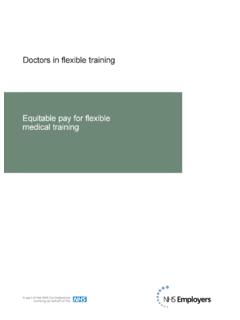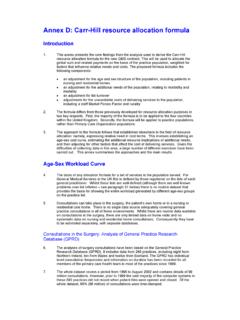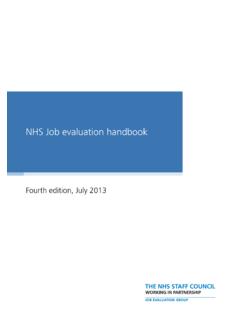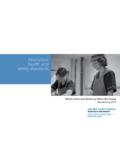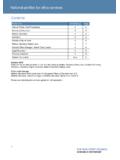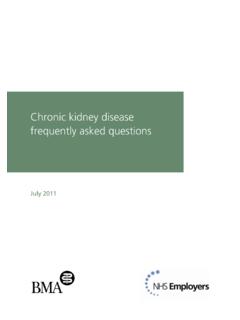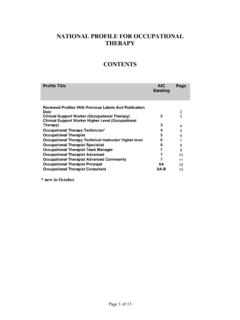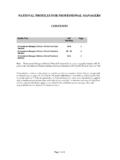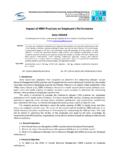Transcription of GOOD ROSTERING GUIDE - NHS Employers
1 GOOD ROSTERING GUIDEMAY 2018 CONTENTSI ntroductionKey principles of good ROSTERING under the 2016 junior doctor contractRoster designRoster managementManaging leave requests in rotas, rosters and work schedules for doctors in trainingNon-resident on call rotasGood rota design and ROSTERING recommendations for LTFT doctorsAppendicesMAY 2018 GOOD ROSTERING GUIDE 3461013172226 May 2018 Good ROSTERING guide2 INTRODUCTIONAs part of the 2016 ACAS agreement between NHS Employers and the British Medical Association (BMA), a commitment was made to work collaboratively to develop good ROSTERING guidance to support Employers and doctors. This guidance sets out the ways in which good ROSTERING practice can be utilised to develop rotas.
2 It aims to support and create an effective training environment that also meets the needs of the service, while enabling flexibility for doctors and Employers , both of whom have a stake in the process. The ongoing challenges facing the NHS underline the importance of organising resources effectively and efficiently in a way which brings mutual benefits to organisations, patients and doctors in the planning and delivery of high quality patient care. We have put together this good rota design and roster management guidance based on principles that we believe can be used to provide the framework for a collaborative approach. This GUIDE will enable rota co-ordinators, managers and doctors to meet their shared responsibility for providing the best possible patient care and improving work life balance for doctors.
3 We are grateful to members of the NHS Employers working group and to representatives of the BMA for their work in developing this guidance. May 2018 Good ROSTERING guide3 Paul WallaceDirector of Employment Relations & RewardNHS EmployersDr Jeeves WijesuriyaBMA Junior Doctors Committee ChairKEY PRINCIPLES OF GOOD ROSTERING UNDER THE 2016 JUNIOR DOCTOR CONTRACTKey overarching principlesTechnological solutions to improve both ROSTERING and managing a live rota should be used wherever possible, particularly to support safe shift swapping where principles, and the ROSTERING guidance as a whole, are aimed at doctors in training but may be relevant to other staff groups with ROSTERING is important to remember that staff on a rota are individuals with lives, families, commitments and priorities outside work.
4 Thoughtful ROSTERING that takes this into account can help improve work/life balance which has a significant impact on overall quality of life for doctors. This is vital when ensuring trainees with protected characteristics are afforded their rights under equalities should be designed intelligently and thoughtfully, taking into account the conclusions from relevant studies on the negative implications of fatigue for doctors and patients. Rotas must be designed and managed in a way that allow juniors to get the breaks they are entitled to according to the contract, as financial penalties can apply when these are patterns vary significantly across different specialties and work environments so often there is no one size fits all approach.
5 The views of trainees with knowledge and experience of a given specialty, or working pattern type, should be taken into account to ensure rotas are designed correctly for them. When designing rotas, consideration should be given to the intensity of workload and the demand that will be placed upon doctors working these rotas. There should be a clear process in place for managing the live roster, in particular ensuring flexibility is possible for those booking leave or anyone who needs to swap shifts. Rota designRota design should be a collaborative process, with equal opportunity for both Employers and doctors to input into the process, and a commitment to reach agreement on final rota design through a clear and transparent rotas should comply with both the letter and the spirit of the law.
6 A rota may be strictly compliant with the rules, but can still be poorly designed. Being compliant with all the relevant rules in the terms and conditions is the minimum that is required, and workload intensity should also be taken into account when considering whether a working pattern is safe. A well-designed rota avoids excessive variability of shifts which can increase fatigue. It has a balanced rota cycle, with different types of shifts evenly distributed, allowing for flexible access to annual leave so that all those on the rota have an even share. When designing rotas, managers will need to ensure that all doctors can take their full leave allowances (study, annual, etc) with sufficient capacity to be prepared for unexpected absences such as sick leave.
7 Rotas should reflect a realistic and safe assessment of service need, with actual work done when on-call, shift handover, and administrative time included accurately. MAY 2018 GOOD ROSTERING GUIDE May 2018 Good ROSTERING guide4 May 2018 Good ROSTERING guide5 The process of rota design should start as early as possible, to ensure that accurate job information can be made available well in advance of the start of a post to ensure adherence with the code of practice timeframes. Training is work for junior doctors, and rotas should be structured around training needs as well as service needs to ensure that there is sufficient time for training and access to study should be rostered according to genuine service and training needs, not in a way that is designed to reduce the payment of enhancements such as for night and weekend work.
8 It can be particularly challenging to design rotas effectively for less than full time (LTFT) trainees. These should be designed taking into account the specific needs of these trainee(s) instead of being planned with a full-time worker as the automatic default. Non-resident on-call (NROC) rotas can be particularly challenging to design, the roster should accurately reflect the work that will be done to allow for both fair pay and sufficient rest and breaks. Consideration should be given to whether the rota needs to be designed to be a standalone or whether it could be combined with another to create a greater pool of resource and allow greater a live rosterOnce a rota is designed and finalised it should not be forgotten about, but regularly checked and updated where necessary, taking into account unforeseen issues that may arise when it is used in practice with a clear process for implementing changes including notice existence of rota gaps should be acknowledged and steps taken to find a resolution, adhering to rota-specific minimum safe staffing levels and any other constraints.
9 Such as the required flexibility for leave across the is important to ensure training time is protected for all trainees, including LTFT trainees, and not compromised by reduced working hours. Flexibility is also especially important for a number of trainees, for example those who have caring responsibilities or health a doctor has specific working requirements for health reasons, recommendations made by occupational health must be factored into the design of the is important to check regularly whether NROC is still the most suitable working pattern, or if changes in the nature of the workload merit a switch to using full shifts, and that the expected hours of actual work reflect the should facilitate the commitment in the 2016 contract to compensation such as pay or time off in lieu (TOIL)
10 , for any additional work junior doctors are required to do outside of their agreed work schedule. Rotas should be amended accordingly where exception reporting leads to a work schedule :Rota template working pattern rota populated with specific details including staff names and dates. ROSTER DESIGNINTRODUCTIONA roster, in its most general form, is used to: forecast the staffing levels and duties required to maintain the safe running of a service facilitate the training and professional development of staff allow for full leave entitlements to be taken. Once a rota has been established, the ROSTERING process will transform the generic rota template into a live document detailing the deployment of staff within specialties, teams and/or departments on a day-to-day design of a roster will consider factors such as patient needs, staff needs, organisational (employer)

